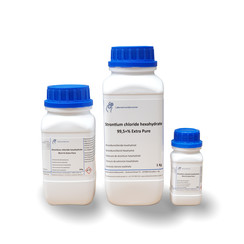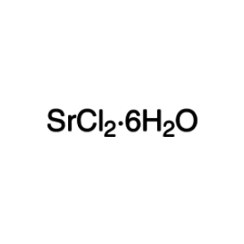You have no items in your shopping cart
Strontium chloride
Strontium chloride (SrCl2) is a salt of strontium and chloride. It is a typical salt, forming neutral aqueous solutions. Like all compounds of Sr, this salt emits a bright red colour in a flame; in fact it is used as a source of redness in fireworks. Its chemical properties are intermediate between those for barium chloride, which is more toxic, and calcium chloride.
Strontium chloride is the precursor to other compounds of strontium, such as yellow strontium chromate, strontium carbonate, and strontium sulfate. Exposure of strontium chloride to the sodium salt of the desired anion (or alternately carbon dioxide gas to form the carbonate) leads to precipitation of the salt
Strontium chloride is often used as a red colouring agent in pyrotechnics. It imparts a much more intense red colour to the flames than most other alternatives. It is employed in small quantities in glass-making and metallurgy. The radioactive isotope strontium-89, used for the treatment of bone cancer, is usually administered in the form of strontium chloride. Sea water aquaria require small amounts of strontium chloride, which is consumed in the production of the exoskeletons of certain plankton.
Dental care
SrCl2 is useful in reducing tooth sensitivity by forming a barrier over microscopic tubules in the dentin containing nerve endings that have become exposed by gum recession. Known in the U.S. as Elecol and Sensodyne, these products are called "strontium chloride toothpastes", although most now use potassium nitrate instead which works as a nerve calming agent rather than a barrier.
Biological research
Brief strontium chloride exposure induces parthenogenetic activation of oocytes which is used in developmental biological research.
Ammonium storage
A commercial company is using a strontium chloride-based artificial solid called AdAmmine as a means to store ammonium at low pressure, mainly for use in NOx emission reduction on Diesel vehicles. They claim that their patented material can also be made from some other salts, but they have chosen strontium chloride for mass production. Earlier company research also considered using the stored ammonium as a means to store synthetic Ammonium fuel under the trademark HydrAmmine and the press name "hydrogen tablet", however, this aspect has not been commercialized. Their processes and materials are patented. Their early experiments used magnesium chloride, and is also mentioned in that article.


